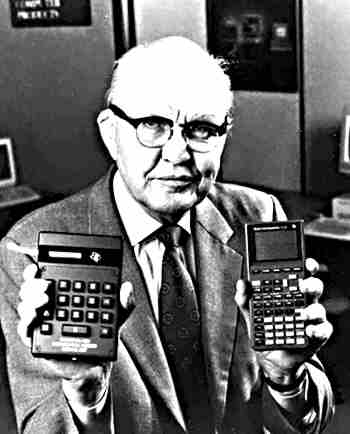| Invention of the Microchip |
| Written by Historian | |||
Page 1 of 2
Should we include the inventor of every important electronic device in the list of computer creators? Should the man who invented the valve, John Ambrose Fleming (1894-1945), be given a place in the history of computing? Probably not, but the use of silicon to create integrated circuits is so central to the modern computer that the situation is very different. It is doubtful if the chip would have been worth inventing at all if it wasn't for its potential use in computers and it is certain that computers would still be rare without the silicon chip. So close are the two that when the personal computer was first introduced it was very common for the press to become quite confused about the identities of the microchip and the microcomputer revolution. Interestingly the technology of the microchip was invented by two people - Robert Noyce and Jack Kilby.
Robert Noyce (1927 - 1990)
Jack St. Clair Kilby (1923-2005)
Size mattersThe first electronic computers were huge because the individual active elements - the valves - used to make it were large and because all the interconnecting wiring need space. The very size limited the power of the machine in two different ways. The first was the sheer volume needed for a machine with a large number of active elements and the second was the time it took for signals to travel along the connecting wires. These were two vital reasons why the size of a computer has to be reduced before it could become really useful. Move to transistorsUsing transistors was the first step in reducing the total size of a machine by reducing the size of the active element. The trouble was that it did very little for the interconnection problem. Being able to cram more active devices into the same space simply increased the number of connections that had to be made. The more you crammed in the more the number of connections increased - this became known as the "tyranny of numbers" and it had to be solved to allow the computer to progress. When William Shockley, one of the inventors of the transistor, set up shop in what was to become Silicon Valley he recruited the best people he could find. Robert Noyce was so confident that he was among the best that he rented a house near the company before the interview! He didn't stay with Shockley for long. In 1958 he and a group of engineers left to found Fairchild. It is an interesting footnote that they each invested $500 in this new company. Around about the same time Jack Kilby had just started with Texas Instruments which was definitely not located in Silicon Valley. At the time TI was trying to make a name for itself in the defence business and one of their projects was to produce a sort of electronic lego. The idea was the components would be fitted into some kind of standard connector which could be pushed together to make circuits. TI had a policy of everyone taking their holiday at the same time but Kilby hadn't worked long enough to be entitled to a holiday - so he worked on while the plant was shut down. He knew that he would be working on the Micro-Module project when the holiday was over and he didn't think it would work. So he tried to find an alternative. Silicon to the rescueIn his previous job Kilby had been involved in a plan to place components on a ceramic base so perhaps this was the spark that gave rise to his good idea - to build everything on a single piece of silicon. To us with the benefit of hindsight it now seems less of a leap of the imagination but that is because we don't suffer from the preconception that a different material is needed for each type of component. Carbon makes resistors, ceramic and metal make capacitors, copper makes connecting wires and inductors and germanium or silicon make transistors. The idea of trying to make everything out of germanium, or the then new silicon, seemed a bit silly. Kilby worked out that it could be done. The start was a silicon resistor - an undoped strip of silicon - then a silicon capacitor - a reverse biased diode. The beauty of the idea was the components could all be made on the same slice of semi-conductor material complete with transistors and wiring.
The first chip - an oscillator When the TI holiday was over Kilby was given the go ahead to try the idea - but only after he demonstrated that each of the components he described could indeed be made. Working alone he hand carved a piece of silicon to make a resistor and used a standard PN junction to show that the capacitor worked. The next step was to make everything on a single chip. The material was Germanium and the internal connections between the components were made by hand-applied gold wires. This made the first working integrated circuit, a phase shift oscillator, looked like a bird's nest in miniature ... but it worked. |
|||
| Last Updated ( Sunday, 05 January 2025 ) |



